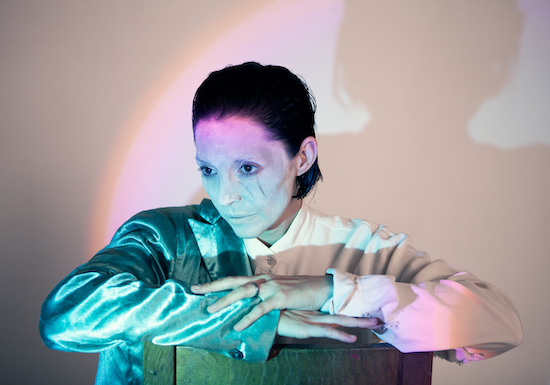Credit Teri Varhol
As a child, at night, Elizabeth Bernholz (aka Gazelle Twin) saw the outline of a black dog: “moving by my bedside – not terrifying but lingering. Looping. Tailing. Restless. Keeping me awake”. She explained to Emma Garland in her recent Quietus interview that the eerie shape could be attributed to a general sinisterness in her parents’ Victorian house, or something misremembered (her brother confessed he’d seen the same dog-like silhouette) – but what it was remains uncertain. Bernholz sits on the fence when it comes to believing in the paranormal.
Bernholz explains she is now as a parent experiencing a “…recurring nightmare of a dark presence waiting for me in a house full of unused rooms. Inevitably it gets me. It violently levitates my body and my child’s. An unstoppable force. A terrible thing”. In Freud’s native German, his concept of uncanny is actually written as ‘unheimlich’, which really translates to ‘unhomely’, as in ‘not of the home’. When we are faced with an uncanny object or situation, we experience the return of something familiar in this unfamiliar state – which causes us anxiety for some forgotten reason. Heimlich also translates – interestingly – to ‘secret’.
Whether or not you’re a fan of Freud, Bernholz – like many artists that came before her – finds the home and its domestic objects to sometimes have an uncanny quality (think Meret Oppenheim’s furry teacup known as Object). It can also be a site of secret oppression too: “Freedom is buried here,” she cryptically sings on the opening track ‘I Disappear’. For Bernholz, domesticity is (both as a child, and now as a mother herself) frequently disrupted by paranormal forces, and this shapes the sounds she chooses. It’s very different in intention to Björk’s Vespertine, which uses a similar palette of found objects taken from the house. According to producer Marius de Vries in Sound on Sound, Vespertine was driven by an “overriding aesthetic of being homely and comfortable”. On Black Dog, the organic sounds – like the dull heartbeat thud on ‘Black Dog’ and the wooden seesawing of ‘Unstoppable Force’ – create anxiety, rather comfort.
Black Dog makes me think of Robbin Schiff’s Womanhouse installation ‘Nightmare Bathroom’. A woman sits in a bathtub while the loose outline of a snake rises to meet the edge of her face. The scene seems lit from odd angles, and the woman’s ephemeral form is made out of loose pink sand. Schiff stated that: “Even though the bathroom can be a refuge and a private place, I have always been afraid there. It is not a rational fear. It may stem from the fear I had in childhood of being sucked down the drain with the water…”
But all this comes with a bit of a disclaimer. Psychoanalytic readings of art might actually say a little bit about the work, and also what you bring to the story through your own introspection. By taking this approach, you have to accept that it doesn’t offer much in the way of resolution. Bernholz plays with this tension really well; the grey area of whether her ghosts are fictitious or not, in a way that feels incredibly convincing – it is real to her. It is a discombobulating means to articulate to herself, and to us through sound, what she can’t explain in concrete terms. Reducing the soundworld of Black Dog to simply a symptom of Bernholz’s childhood fear would also be – let’s face it – extremely boring.
Bernholz doesn’t focus too hard on the incident of seeing her black dog per se. On the title track, she urgently repeats the lines, “I tell you this dream, this dream I had,” as if rummaging through old memories to unsuccessfully locate the exact experience. The measured clangs that walk you through the piece seem to be Bernholz herself, pacing in slow motion. There’s no big reveal – despite its momentary build up around the three minute mark – the track structurally has us walking in circles.
Phantoms serve as a black hole in the centre of the work, around which the album’s dread surrounds. It’s like she’s retracing and recording the atmosphere of her childhood house, the way that the dimensions of a space can create horror. Hitchcock did this by using camera perspectives that no human being would look out from, Bernholz does this, for example, on ‘The Long Room’ by using samples that sound like people talking, but from a distance or through walls – barely perceptible.
I love the way that on ‘I Disappear’, the synth drones vanish until we are left with Bernholz’s hovering voice accompanied with white noise. Which seems to me to create the sense of when you are lying awake at night, but the silence isn’t silent, because your ears are still gently ringing. At the end of the track we are left with this white noise – or perhaps tinnitus – like the sound of a hospital monitor flatlining but pitched down, for around a whole minute.
You are drawn to anticipate Bernholz’s voice, which you spend much of your listening experience waiting to emerge and break through the drones. But it’s the gaps between these moments which make it breathtaking. Bernholz projects her voice in a way that makes it sound like it’s not attached to a physical body – much like Diamanda Galas’. Her sonically altered, sometimes low, sometimes high voice sits on top of each track like a disembodied narrator. It disarmingly cuts through her languorous synth drones, with you latching onto her every word in case it provides some sense of clarity to the strange harmonic resonances. She dangles tantalisingly few clues however. While Bernholz has used her voice to similar effect throughout her work as Gazelle Twin, it’s at its most commanding here.



